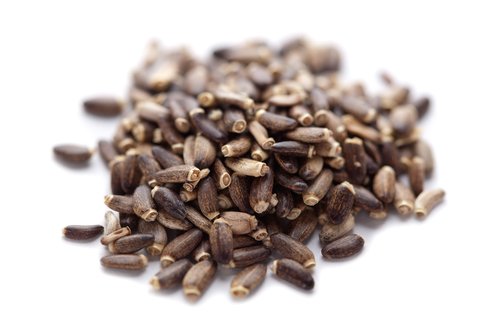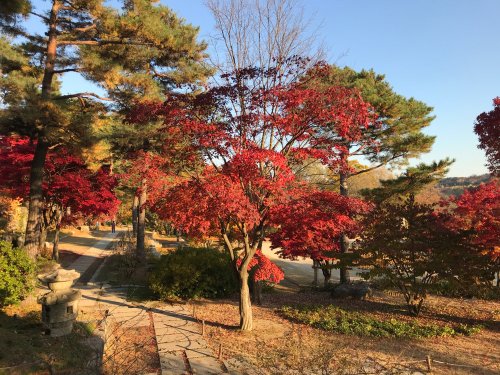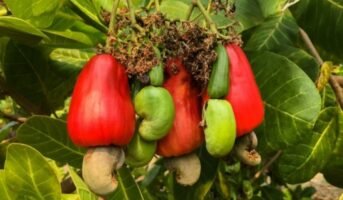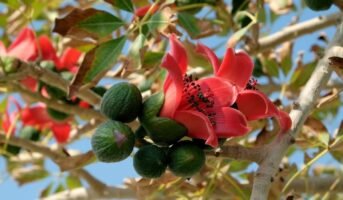One of the world’s most beautiful tropical plants is the Gulmohar tree. Large, blossoming Gulmohar trees are deciduous trees. The tree looks attractive and provides a light aroma. The Gulmohar tree is one of the most well-liked outdoor plants in India. Despite being a native of Madagascar, this plant thrives in India’s tropical climate.
The scientific name of the Gulmohar tree is Delonix Regia. Numerous other characters are also used to refer to it. Gulmohar is also known as the royal poinciana, Krishna Chura, the Mayflower tree, the flamboyant tree, the peacock tree, and the flame tree. The Gulmohar tree flowers in the summer continue to bloom until the monsoon.
In addition, the five petals of the Gulmohar plant are divided into four identical orange petals and one slightly larger fifth petal with patches of yellow and white. Therefore, the centre of the bloom also has strands. Every Gulmohar plant has a floral bedspread in the morning, a sight to behold. Although they are more delicate, Gulmohar tree leaves resemble ferns.
The knowledge you require about the Gulmohar plant has been put here if you want to grow this Gulmohar tree.
Gulmohar tree: Quick facts
| Common name | Royal Poinciana, Gulmohar |
| Scientific name | Delonix regia |
| Sun tolerance | Full Sun |
| Height | 5 – 12 m (18–40 ft) |
| Spread | 3.5 – 5 m (12-18 ft) |
| Growth rate | Fast |
| Bloom time | Spring |
| Colour | Green |
| Flower Colour | Red, Orange, Yellow |
| Type | Tree |
| Native | Worldwide tropical and subtropical regions |
There are many lovely names for this beautiful tree. Around the world, it is referred to by several names. Its name comes from various sources, some connected to its look and some to its cultural background. But it is generally referred to as Delonix regia.
Flamboyant, Peacock flower tree, Pupil’s tree, Flame of the forest, and Flame tree are some of the most popular alternate names for this tree. Due to its stunning orange-red blossoms, which partially resemble fire colour/fire in a forest, the Gulmohar tree is known as the “Flame of the Forest.”
Flamboyant is a common name for it—striking means showy or bold in appearance in its literal sense. The name Gulmohar translates to “Royal Poinciana” in English.
The legume family is the same, and Fabaceae, the bean family, includes this tree. Since the Gulmohar tree does not nodulate, it is referred to as a non-nodulating legume.
Gulmohar tree: Botanical classification
| Kingdom | Plantae – Plants |
| Subkingdom | Tracheobionta – Vascular plants |
| Super division | Spermatophyta – Seed plants |
| Division | Magnoliophyta – Flowering plants |
| Class | Magnoliopsida – Dicotyledons |
| Subclass | Rosidae |
| Order | Fabales |
| Family | Fabaceae – Pea family |
| Genus | Delonix Raf. – delonix |
| Species | D. regia |
know about: krishna chura tree
Gulmohar flowers

The Gulmohar tree’s blossoms, which come in various colours and are incredibly eye-catching and elegant, are its main draw. Five petals make up the flower, four of which are at the base and one of which is larger than the other four. The large one is standard, and the larger one is Scarlet. The scarlet is particularly notable its gorgeous orange-red colouring. The largest one, called Standard, is white and yellow variegated. The Standard petal turns crimson as it ages as well.
The honey bee is drawn to the flowers because of their colour. During the blooming season, bees are abundant. Spring and Summer are the seasons when the tree typically blooms. The Gulmohar blossoms fall during this time and create a carpet of blooms on the ground. Individuals may be compelled to pause and take in the brief scene created by the fallen Gulmohar flowers.
This tree’s flowers are solitary, meaning they grow singly rather than in clusters. The Gulmohar tree’s flowers are monoecious. It is a bisexual tree, which indicates that cross-pollination takes place. The influence of wind is responsible for the majority of pollination.
Gulmohar fruit
The pod is the name of the fruit of the Gulmohar tree. Its interior is filled with brutal, dark-brown seeds frequently used to spread this plant. Early on, the pod is green and floppy, but as they age, they become firm, dark brown, and woody.
Pods mature and split into two halves, causing the seeds to disperse. The pod’s seeds are tiny, measuring two cm in length and weighing only 0.4 grams. However, in the right circumstances, roots, after being dispersed, grow to become a whole tree. Despite this, the majority of seeds do not germinate. It is because of their physical dormancy or tough outer shells.
Gulmohar leaves
The Gulmohar tree’s leaves are compound, also called double pinnate leaves (Feathery). With their brilliant light green colour, they resemble fern fronds. Both primary and secondary leaflets are present in the leaves. These leaflets hold up the cluster of flowers. No matter which season starts, the leaves are always green. Gulmohar is consequently next to an evergreen tree.
Due to the tree’s deciduous nature, the leaves fall in November, when autumn officially begins. The plant isn’t entirely bare, though, as some leaves are still present. However, the entire plant is covered in flowers and has fewer leaves during flowering.
Gulmohar stem or trunk
The stem is straight and develops very quickly, reaching its maximum height within the time it takes the Gulmohar tree to get its full height of (five to 12) meters (18–40 ft). Similarly, the canopy’s spreads at maturity range from 12 to 18 feet. It appears like a vase because of this. Gulmohar’s plant broad spread crown gives it the appearance of a letter “T,” making it ideal for usage as a street tree.
Each year, the Gulmohar tree gains roughly five feet. Comparatively speaking to other ornamental trees, this is relatively rapid growth. The stem is woody throughout its existence. However, the tree’s roots are not deep. Therefore, there is a potential that a tree will fall or its trunk will break during a strong wind.
Gulmohar tree: Propagation
The Gulmohar tree can be grown in two ways – from cuttings and seeds.
From seeds

Gulmohar grows either naturally or artificially from seeds. It is the technique that is used the most. A fruit or pod is formed after pollination. The pod is green when it is young, but as it ages, it turns brown and splits into two pieces, releasing hard brown seeds.
This tree’s seeds have physical dormancy. They have a tough exterior. The germination of the tree is practically impossible without breaking this outer coat. Therefore, before seeding, we use the scarification process to disrupt dormancy by softening the outer layer. You can do this by soaking the Gulmohar seeds in warm water for 24 hours or using a knife to form a small scar in the seed. It guarantees that water and oxygen enter the seeds, causing germination.
The Gulmohar tree needs five to twelve years to mature from seed before it may begin to bloom. Therefore, Gulmohar’s seed germination period varies considerably. A germinating period can range from (12 to 349) days. Germination happens within 10–12 days if we follow the technique of breaking the dormancy described above; otherwise, it may take up to 349 days.
From the cutting
Although it is less common, growing Gulmohar plants from cuttings has various advantages and is just as effective as growing them from seed. Semi-hardwood cutting is preferred in Gulmohar. It means that cutting should be made from a branch growing along the side of the sun throughout the current or previous season. The extension should be sound, and the cutting should have two to three nodes with a measurement of roughly 30 cm long. The cut should be made slantingly while being driven.
After cutting, you can quickly start the rooting process by dipping the portion into a rooting hormone, such as auxin. It can be planted in damp soil after dipping. After a few days, the root begins to sprout leaves.
A new plant that is faithful to type is produced by cutting propagation. It works best for Gulmohar trees with yellow flowers. The primary benefit of growing this tree from a cutting is that it blooms more quickly than a tree planted from seed.
Gulmohar tree: Growth rate
The growth rate of a Gulmohar (Delonix Regia) tree can vary depending on various factors such as soil quality, sunlight exposure, water availability, and climate conditions. When cultivated under ideal conditions, this magnificent tree can reach its full height of 30 meters within a span of 15 to 20 years. However, what makes the Gulmohar truly captivating is its ability to bloom and showcase its stunning display of red-orange flowers in the initial years of growth. It typically starts flowering within the first few years, adding a burst of vibrant color to its surroundings. As the tree matures, its growth rate gradually slows down, allowing it to develop a sturdy and well-established structure. It is crucial to provide proper care and maintenance to ensure the Gulmohar’s healthy and rapid growth.
Know about: miniature roses
Gulmohar tree: Care tips

Soil preparation for Gulmohar tree
This tropical plant needs a sufficient amount of warmth from the soil. This plant is native to Madagascar, yet strangely, it has quickly adapted to the soil in India. You must begin to prepare the soil as soon as you spot the Gulmohar tree saplings so that you can transplant them from the seed box. It would help if you kept the pH in the range of 6.5 to 7.5 to properly prepare the soil for this plant.
Additionally, the tree shouldn’t have any issues with water blocking. Make sure it drains well. Compost that promotes plant growth must be added to the soil to make it fertile. Finally, you must give the plant the proper fertiliser throughout its early stages. Plants’ leaves might burn if there is too much fertiliser applied.
Location of Gulmohar plant
The Gulmohar plant starts to spread quickly and grow taller once the saplings develop into plants. The tree’s crown requires much area and space to distribute appropriately. Therefore, putting the tree in an open place is generally ideal.
The Gulmohar tree starts to spread quickly and grows taller once the saplings begin to develop into plants. The tree’s crown requires much area and space to circulate properly. Therefore, putting the tree in an open place is generally ideal.
Plant Gulmohar trees in areas with lots of sunlight
Gulmohar trees also have shallow roots, which is one drawback. In addition, a large tree may likely be uprooted during heavy winds or storms. Therefore, you must avoid placing the plant in a windy area while choosing its location. In addition, as the Gulmohar plant does not adhere to the ground properly, there shouldn’t be any buildings or residences nearby as high winds could damage them.
Watering of Gulmohar plant
You must water the plant daily and maintain moist soil in the early stages. Although it doesn’t mind being overwatered, being underwater can harm the plant, especially when young. When the plant’s blooming season arrives in the summer, extend the watering period. Contrarily, you can cut back on watering throughout the winter. You won’t need to bother much about watering the tree until it is firmly planted in the ground and has had time to grow.
Sunlight requirement of Gulmohar plant
The Gulmohar tree requires at least six hours of sunlight per day to develop. Even though it can withstand days of heavy rain, this plant prefers sunlight. Therefore, ensure the location receives enough sunlight throughout the year when choosing a site.
Right temperature for Gulmohar plants
For the Gulmohar tree, a temperature of over 7.0°C is ideal. Gulmohar plants thrive in warm climates as tropical plants do. It also likes humidity, so that’s a plus. The Gulmohar tree grows exceptionally well in areas of India that are referred to as the “hot belt.” Despite flourishing in nearly every region of India, this tree cannot withstand frost and drought.
Gulmohar tree: Fertilising requirements
You can fertilise a young plant once every three weeks using organic manure. The plant only needs fertiliser once a year, during the growing season, once it has reached maturity. The plant will blossom more readily with a balanced fertiliser.
Pruning of Gulmohar plant
The Gulmohar tree proliferates. As it matures, it can grow up to feet each year. Regular pruning is necessary to get the ideal shape, especially throughout the plant’s growing phase. The plant’s branches are still tender at this point. Pruning also aids in root vigour. You won’t need to think about pruning it once it matures.
Gulmohar tree: Pests and diseases
The Gulmohar plant has a high level of resistance to insects and illnesses. In addition, it is free of mosquitoes and vermin.
Importance of Gulmohar tree
Gulmohar tree holds immense cultural significance along with being of great importance as an ornamental plant.
Ornamental importance
The Gulmohar in bloom is a real work of art. This plant is a favourite among many people to add to gardens to make them look more beautiful. For this reason, many cities and businesses grow Gulmohar trees along the sides of the roadways. In addition to the lovely blossoms, it offers shade in hot, sunny locations.
Cultural importance
The Gulmohar plant is revered as a sacred tree in Kerala. This flower is revered in India and outside due to its enormous appeal. This flower is referred to as the city flower in Selangor and Malaysia.
Gulmohar tree: Bonsai
The Gulmohar tree’s bonsai is quite gorgeous. A small container is used to cultivate trees in the miniature form known as bonsai. This tree must undergo rigorous training and trimming if you want to make a bonsai. The seed should first be displayed and given a year to grow. Then, it should undergo trimming and training after a year. In a few years, limiting the amount of food and maintaining it will produce an excellent bonsai.

Source: Pinterest
Gulmohar Tree: Uses
Gulmohar tree is used for a variety of commercial purposes. These include:
- The Gulmohar plant’s wood is utilised as fuel. This wood has a calorific value of 4600 kcal/kg.
- In bee farming, the Gulmohar blossoms are fed to the bees.
- This plant produces thick water-soluble gum. The furniture and textile industries employ this natural gum as a binding agent.
- Pungam Oil, particularly beneficial in tanning, is produced from the seeds.
- Jewellery makers frequently employ the elongated, hard seeds of the Gulmohar plant as beads.
Benefits of Gulmohar tree
There are numerous medicinal as well as environmental benefits of Gulmohar trees. These include:
- Gulmohar trees are endowed with a variety of medicinal qualities. Along with having wound healing effects, they have antibacterial, antifungal, antimicrobial, antioxidant, gastro-protective, antimalarial, anti-inflammatory, and cardio-protective characteristics.
- The leaves of the Gulmohar tree are anti-diabetic. These leaves’ methanol extract is used to lower blood glucose levels.
- The leaves of the Gulmohar tree may offer hepatoprotection.
- These plants have anti-diarrheal qualities in their leaves.
- It has flavonoids that support liver health protection.
- Gulmohar tree leaves are used to make an essential oil with antifungal qualities.
- The Gulmohar plant treats various bodily ailments like constipation, diabetes, malaria, rheumatoid arthritis, inflammation, and pneumonia in traditional and ancient medicine.
- This plant is utilised to restore the soil.
- It may also aid in repairing atmospheric nitrogen.
Gulmohar Trees: Disadvantages
The Gulmohar tree has certain drawbacks while being a genuinely exceptional plant and offering immense beauty. The most significant disadvantages you could experience while this tree is growing are listed here:
- The roots of this tree are short. Because of this, it is vulnerable to breaking in strong winds and other bad weather conditions.
- Gulmohar Fallen Tree
- Insects like to eat wood.
- The space that the tree takes up increases as it gets bigger. Therefore, it is not advised to plant this tree near a house.
- The leaves of the Gulmohar tree frequently fall, covering the entire area and making it impossible to move around.
How to grow Gulmohar at home?
The summer months are ideal for growing Gulmohar because it requires a lot of space to develop.
When is the best time to plant Gulmohar trees?
The best time to plant a Gulmohar tree is in the autumn or spring, when temperatures are neither very high nor very low and the tree can establish roots before hot or cold weather sets in.
Soil
Although Gulmohar is a native of Madagascar, it has adapted to the soil types throughout the entire tropical world. It is ideal for the soil to be sufficiently warm and above freezing. A proper manure-fertiliser ratio is also essential.
Preservation of the seeds
You can cultivate Gulmohar either by the scarification process (which involves slicing or weakening the seed’s outer coating so that it can germinate easier) or by soaking the seed in hot water for ten minutes before sowing them for enhanced germination.
Ongoing maintenance
Moderate sunshine exposure is necessary. This plant matures and blossoms quite quickly thanks to its fast growth of up to five feet each year. Therefore, pruning should be done routinely and adequately during the plant’s early growth stages. Pests won’t be an issue because this plant is exceptionally resistant to most annoying pests, but its wood is susceptible to animals and insects.
Gulmohar tree: Toxicity
No part of Gulmohar tree is even slightly toxic to either humans or animals. It is absolutely safe to plant this tree in your garden or anywhere else.
All living things have received the Gulmohar tree as a gift from nature. The Gulmohar tree has constantly improved people’s lives through its distinctive beauty and the many uses it serves. You must therefore preserve this tree’s exquisite beauty.
FAQs
Is the Gulmohar tree of Indian origin?
The Gulmohar is a street tree commonly planted in India due to its naturalised status and, of course, its breathtaking blossoms. However, it is cultivated as an ornamental tree in many tropical regions. It is also known as a royal poinciana or flamboyant in English.
Does Gulmohar have a rapid population increase?
This plant matures and develops rather quickly and can grow up to five feet yearly.
How long does a Gulmohar tree live?
If grown naturally, it takes four to five years to mature and ten years to develop from a cutting.
Is Gulmohar an evergreen tree?
A sizable tree with fern-like leaves, Gulmohar is deciduous. Flame tree, royal poinciana, and peacock flower tree are different names for Gulmohar.
What brought Gulmohar to India?
Gulmohar is a showy tree in bloom found in its native Madagascar by botanist Wensel Bojer in the early 19th century. The British brought it to India along with Bangalore and KGF. They grew it where they lived in colonies. Mining settlements still have many flowering trees.
Housing News Desk is the news desk of leading online real estate portal, Housing.com. Housing News Desk focuses on a variety of topics such as real estate laws, taxes, current news, property trends, home loans, rentals, décor, green homes, home improvement, etc. The main objective of the news desk, is to cover the real estate sector from the perspective of providing information that is useful to the end-user.
Facebook: https://www.facebook.com/housing.com/
Twitter: https://twitter.com/Housing
Email: [email protected]











